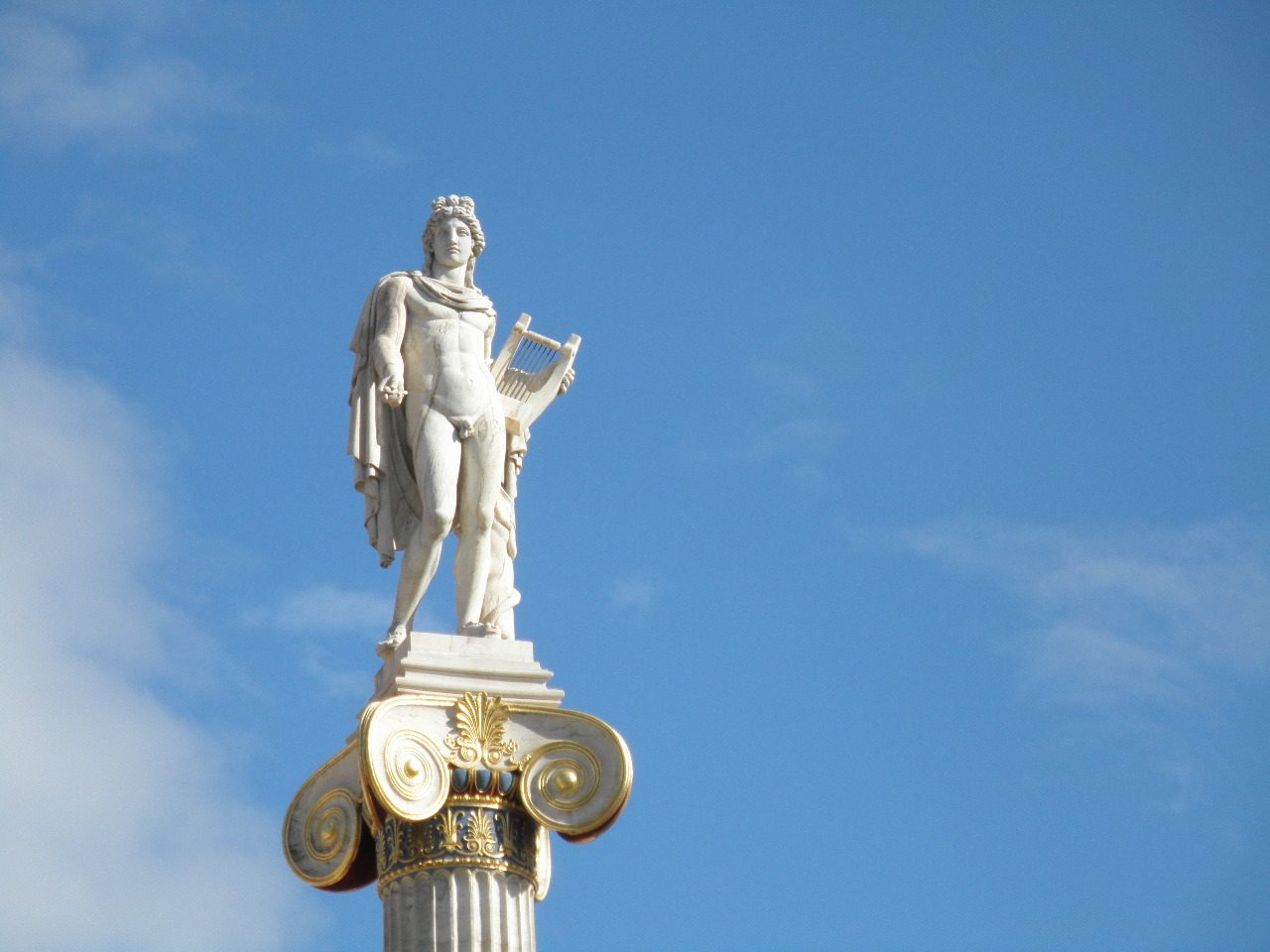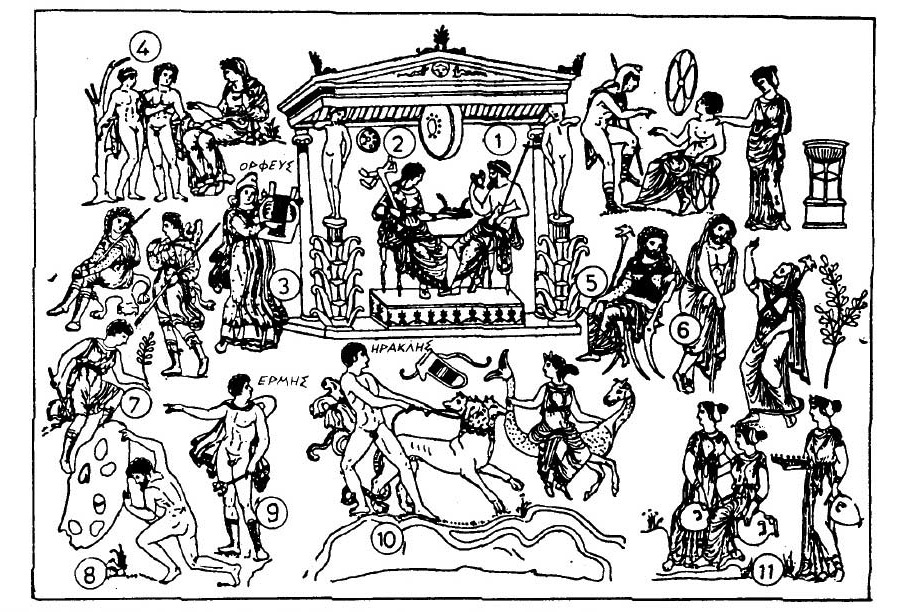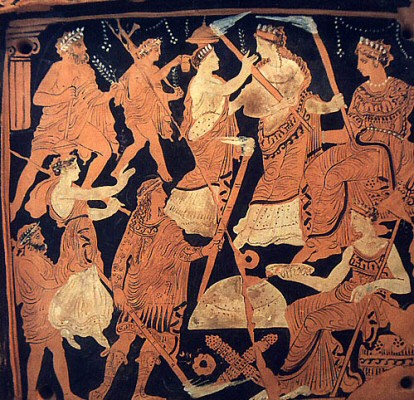Greek Mysteries
 The term "Mystery" derives from Greek mysterion, in this context meaning "secret rite or doctrine". Mysteries is the name given to those religious assemblies of the ancients, whose ceremonies were conducted in secret, whose doctrines were known only to those who had obtained the right of knowledge by a previous initiation, and whose members were in possession of signs and tokens by which they were enabled to recognize each other. For the origin of these mysteries we must look to the rishis (sages) of India, from whom they passed through Egypt into Greece and Rome, and from whom likewise they were extended, in a more immediate line, to the northern part of Europe and to Britain. The most important of these mysteries were those of Mithras, celebrated in Persia; of Osiris and Isis, celebrated in Egypt; of Eleusis, instituted in Greece; and the Scandinavian and Druidical rites, which were confined to the Gothic and Celtic tribes. In all these various mysteries, we find a singular unity of design clearly indicating a common origin, and a purity of doctrine as evidently proving that this common origin was not to be sought for in the popular theology of the Pagan world. The ceremonies of initiation were all funereal in their character. They celebrated the death and the resurrection of some cherished being, either the object of esteem as a hero, or of devotion as a god. Subordination of degrees was instituted, and the candidate was subjected to probations varying in their character and severity; the rites were practised in the darkness of night, and often amid the gloom of impenetrable forests or subterranean caverns; and the full fruition of knowledge, for which so much labor was endured, and so much danger incurred, was not attained until the aspirant, well tried and thoroughly purified, had reached the, place of wisdom and of light.
The term "Mystery" derives from Greek mysterion, in this context meaning "secret rite or doctrine". Mysteries is the name given to those religious assemblies of the ancients, whose ceremonies were conducted in secret, whose doctrines were known only to those who had obtained the right of knowledge by a previous initiation, and whose members were in possession of signs and tokens by which they were enabled to recognize each other. For the origin of these mysteries we must look to the rishis (sages) of India, from whom they passed through Egypt into Greece and Rome, and from whom likewise they were extended, in a more immediate line, to the northern part of Europe and to Britain. The most important of these mysteries were those of Mithras, celebrated in Persia; of Osiris and Isis, celebrated in Egypt; of Eleusis, instituted in Greece; and the Scandinavian and Druidical rites, which were confined to the Gothic and Celtic tribes. In all these various mysteries, we find a singular unity of design clearly indicating a common origin, and a purity of doctrine as evidently proving that this common origin was not to be sought for in the popular theology of the Pagan world. The ceremonies of initiation were all funereal in their character. They celebrated the death and the resurrection of some cherished being, either the object of esteem as a hero, or of devotion as a god. Subordination of degrees was instituted, and the candidate was subjected to probations varying in their character and severity; the rites were practised in the darkness of night, and often amid the gloom of impenetrable forests or subterranean caverns; and the full fruition of knowledge, for which so much labor was endured, and so much danger incurred, was not attained until the aspirant, well tried and thoroughly purified, had reached the, place of wisdom and of light.
There were a variety of mysteries available in the Greek world and some students of mystical lore in ancient times made a habit of beings initiated into a many of them as possible. The oldest Mystery School of Greece was situated on the island of Samothrace, which was first colonized by the Pelasgians, those Atlanto-Aryan immigrants who were the first settlers of Greece. The most famous of the Mystery Schools, and the last to be destroyed, was the Eleusinian, located in the hamlet of Eleusis, not far from Athens.
Orphism
Among the most famous aspects of ancient Greek religion, the mysteries were traditional initiation rituals, many of them handed down from much earlier times. Herodotus informs us that the Mysteries were introduced into Greece by Orpheus, the son of Apollo, from whom he received his seven-stringed lyre, or the sevenfold mystery of initiation. This alone may be depended upon, from general assent, that there formerly lived a person named Orpheus, who was the founder of theology among the Greeks; the first of prophets and the prince of poets; who taught the Greeks their sacred rites and mysteries, and from whose wisdom the divine muse of Homer and the sublime theology of Pythagoras and Plato flowed.
According to Orpheus, all things may be traced back to a great Principle to which men have tried to give a name, although it is really indescribable and ineffable. Following the Egyptian symbolism, Orpheus speaks of this Principle as "thrice-unknown darkness, in the contemplation of which all knowledge is refunded into ignorance." Proclus, one of the most scholarly commentators on the philosophy of Orpheus, says he taught that a progeny of principles issued from the original Principle, each one of which was stamped with the occult characters of Divinity.

Orpheus playing his lyre before Pluto, king of Hades.
The Orphic system describes the Day and Night as the Great Year of the Universe, at the end of which "Kronos squares the account of the gods, and re-assumes dominion of the most primeval Darkness." Orpheus declares that man's evolution is accomplished by means of innumerable reincarnations. Plutarch expresses the opinion that the myth of Bacchus, which was enacted in the Orphic Mysteries, "is a sacred narrative concerning reincarnation." In the sixth book of the Aeneid, which is an allegorical record of some of the Mystery rites, Virgil speaks of the time elapsing between earth lives: «All these souls, after they have passed away a thousand years, are summoned by the divine ones in great array, to the Lethean river. In this way they become forgetful of the former earth-life, and re-visit the vaulted realms of the world, willing to return again into living bodies».
Lesser and greater mysteries of Eleusis
The Eleusinian Mysteries were famous religious and mystical ceremonies held at at Eleusis, near Athens. Of all the mysteries celebrated in ancient times, these were held to be the ones of greatest importance. The ceremonies which founded by Eumolpus, included purifications and fasts and were sacred to godesses Demeter and Persephone. The Eleusinian Mysteries were divided into the Lesser and the Greater. The former were held at Agrae where, after a period of probation, the neophytes were known as the Mystae, or the "veiled." The latter were held at Eleusis, and those who were initiated therein were known as the Epoptae, or those who saw "face to face."
“But Pindar, speaking of the Eleusinian Mysteries, says: Blessed is he who, having seen those common concerns in the underworld, knows both the end of life and its divine origin from Jupiter.”
- Clemes Alexandrinus, Stromateis III, 3.
The Eleusinian Mysteries, from one point of view, were schools of Eastern psychology, in which the students learned the true nature of the soul, its relation to the body, and the method by which it could be purified and redeemed. The Lesser Mysteries illustrated, through dramatic performances, the condition of the unpurified soul, still entangled in the meshes of its own karmic actions. The Greater Mysteries demonstrated the bliss of the soul which had been purified through spiritual vision and Self-realization.
In the Lesser Mysteries the neophytes were shown that the soul, when invested with a body, undergoes a form of death. "It is death to the soul," Plotinus wrote, "to be wholly immersed in a body and wholly subjected to it." This was demonstrated in the Eleusinian Mysteries by a dramatization of the myth of Demeter and Persephone.
Demeter and Persephone
Demeter was one of the Immortals who dwelt on Mount Olympus. As a cosmic symbol she represented the fructifying principle in the all-pervading Spirit which quickens every germ in the material universe. As an individual symbol she typified the immortal Spirit which sheds its radiance upon every human being and which, being rooted in the Unknowable Causeless Cause, is both omnipotent and omniscient. Her daughter Persephone symbolized the reincarnating Ego which, under karmic law, descends into matter and slowly works its way back to the Source of All, taking with it the results of all experiences gained on the way. This myth is a magnificent description of the method by which the soul which has not yet incarnated upon this globe descends for the first time into a body of flesh.

Eleusinian Mysteries.
Fearing that her daughter would be polluted by contact with matter, Demeter confined her in a house built by the Cyclopes, after which she returned to her own dwelling place among the gods. Jupiter, knowing that Persephone's time for incarnation had arrived, sent Venus to tempt her out of the house. Venus found her weaving the net of destiny in which the embodied soul becomes entangled. Led on by the goddess, Persephone went out into the fields where Pluto, the god of the nether world, saw her and desired her. Picking her up, he carried her down to his own world and shut her up in a dark cavern. There, with Night as a witness, he married her, and the soul and body were united.
One night Demeter dreamed of Persephone, who begged her mother to come to her aid. Girding herself with a Serpent, and carrying two lighted torches in her hands, Demeter started out to find her daughter. After traveling throughout the world, she finally returned to Greece. Weary and sad, she sat down on a stone, where she remained in meditation for nine days and nights. The place where she sat became the site of the Eleusinian School, in which the final initiations occupied nine days and nights. Homer says that this period refers to the nine spheres through which the soul descends into the body. It also has reference to the nine months of pre-natal life which the soul needs to form its body.
After these nine days of meditation Demeter returned to Jupiter and begged him to release her daughter. Jupiter consented, provided that Persephone had not eaten any food during her life with Pluto. But when Mercury, the messenger of Jupiter, reached the underworld, he found that Persephone had sucked the sweet juice from a pomegranate which Pluto had given her, showing that she had tasted the fruits of earthly life and found them sweet. That was enough to prevent her complete release. A compromise, however, was effected, allowing Persephone to spend one half of her time with Demeter, the other half with her husband, Pluto. So, from its first incarnation, the soul communes with its Higher Self during deep sleep and after death, while its waking hours and the years of its earthly life are spent wedded to the body and its interests.
The condition of the unpurified soul after death, which also formed part of the instructions in the Lesser Mysteries, is described by Virgil. After crossing the Stygian lake, Aeneas meets the three-headed monster Cerberus, who symbolizes Astral Plane and the beings detained there. Thomas Taylor classifies them as infants who have met an untimely end, executed criminals and suicides. Aeneas is then taken to the Elysian Fields, or Divine Cosmos, where he finds the souls occupied "in employments proper to the spiritual nature, in giving free scope to the splendid and winged powers of the soul, in nourishing the higher intellect with substantial banquets of spiritual food."
The purpose of the mysteries
As the ultimate purpose of the Mysteries was to free the soul from the dominion of the flesh, the neophytes were shown the difficulties of the Path which lay before them. "Easy is the path that leads down to Hell," Virgil says, "grim Pluto's gate stands open night and day. But to retrace one's steps and escape to the upper regions, this is a work, this is a task." But however great the difficulties, Virgil assures us that they are not insurmountable, since "some few, whom illustrious virtue advanced to heaven, have effected it."
Blessed! thrice blessed! who, with winged speed,
from Hyle’s dread voracious barking flies,
and, leaving Earth’s obscurity behind,
by a light leap, directs his steps to thee.
- Synesius, The First Hymn
The first task undertaken by the probationary disciples at Agrae was that of purification: "For the Mysteries are not imparted to all who are willing to be initiated. It is necessary that those who are not excluded from initiation should first undergo certain Purifications." (Theon of Smyrna: Mathematica.) In this degree of the Mysteries the student learned to control his appetites, to restrain his emotions, to discipline his mind through the study of arithmetic, geometry, astronomy and music. Only when the lower nature is under control, Plotinus says, "will the inner eye begin to exercise its clear and solemn vision."
The student who had passed through this period of probationary discipline successfully was then admitted to the Greater Mysteries of Eleusis. Where at Agrae he had been permitted to see things "through a glass, darkly," he was now ready to see "face to face." Where before he had observed life through the eyes of Persephone, the unpurified soul, he was now ready to look through the eyes of Demeter, the Higher Self. He was now prepared to have the myth of Demeter and Persephone explained to him, and its different aspects unveiled in philosophical doctrines.
The instructions in the Greater Mysteries were given out by a high Initiate who was known as the Hierophant, or Interpreter. He was a sage, bound to celibacy, who devoted his entire time to this holy task. None of the students contacted him personally, and no one was allowed to mention him by name. The instructions were read from a book made of two stone tablets, known as the Petromata. They were imparted to the candidate orally, "at low breath," and were received under the pledge of secrecy, the breaking of which meant death.
The Mysteries were not designed merely to initiate a chosen few into the secrets of nature, setting them apart from the rest of mankind. Their true purpose was rather to enable students to acquire an understanding of the ancient wisdom in order to be the better able to help and teach others. Every one initiated in the Eleusinian Mysteries, therefore, bound himself by the age old pledge: "I swear to give up my life for the salvation of my brothers, who constitute the whole of mankind, and, if called upon, to die in the defense of truth."
For many centuries the Mysteries of Eleusis shed their bright rays over the land of Greece. But the day finally came when dark clouds of ignorance and selfishness began to obscure the light. In 510 B.C., on the advice of Aristogeiton, the State decided to use the Eleusinian School as a source of income. From that time on, every one who entered the School paid an admission fee. By breaking the occult law that spiritual truths cannot be bought or sold, the Mysteries began to degenerate, and by the end of the second century A.D. any one who had the price could become an "initiate." During those six hundred years, the epoptae disappeared one by one, leaving only the mystae behind.
Although the less important Mystery Schools completely disappeared under the cruel and revengeful hand of the Christian Emperor Theodosius, the Eleusiniam Mysteries were not so easily abolished. But in the year 396 the vast Temple of Eleusis, one of the most famous buildings of the ancient world, was reduced to a pile of ashes. So perished the Mysteries of Greece.

